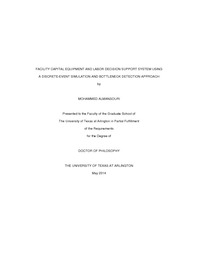
ATTENTION: The works hosted here are being migrated to a new repository that will consolidate resources, improve discoverability, and better show UTA's research impact on the global community. We will update authors as the migration progresses. Please see MavMatrix for more information.
Show simple item record
| dc.contributor.author | Almansouri, Mohammed | en_US |
| dc.date.accessioned | 2014-07-14T20:27:26Z | |
| dc.date.available | 2014-07-14T20:27:26Z | |
| dc.date.issued | 2014-07-14 | |
| dc.date.submitted | January 2014 | en_US |
| dc.identifier.other | DISS-12641 | en_US |
| dc.identifier.uri | http://hdl.handle.net/10106/24445 | |
| dc.description.abstract | Market demand is constantly changing. Therefore, it is critical for companies to be flexible and willing to adapt in order to remain competitive. This study will evaluate bottleneck detection techniques that have been identified in previous research by comparing the performance of each method on all case study models that can be replicated from the literature. The purpose of this analysis is to identify the most efficient and reliable bottleneck detection algorithm(s) which are capable of supporting constraint identification on a wide range of production system classes and configurations. The primary objective will be to identify a robust bottleneck detection algorithm, or a small set of algorithms, that can be broadly applied to various types of production or service provision environments. Discrete-event simulation will be used to support this algorithm evaluation task and will also play a key role in the application of bottleneck detection methods in real-world production scenarios. This research will also integrate financial project justification methods to verify that each proposal to increase production can be financially justified. The net present value and internal rate of return performance measures in conjunction with the equity cash flow and minimum annual revenue requirements project justification methods will be used for this purpose. Both the bottleneck detection techniques and the project justification methods will be applied in order to solve the problem of both demand reduction as well as demand growth. To demonstrate the general applicability of the proposed facilities analysis methods to real-world production or service provision system, a prototype decision support system was developed that can help decision makers determine what modifications are required in order to allow their production systems to adapt to shifts in market demand. The features of the prototype decision support tool will be demonstrated on models of production systems that are derived from actual production operations, with the goal of providing a general capacity analysis and financial justification tool that can be applied to a wide range of production or service provision system scenarios and designs. | en_US |
| dc.description.sponsorship | Huff, Brian | en_US |
| dc.language.iso | en | en_US |
| dc.publisher | Industrial & Manufacturing Engineering | en_US |
| dc.title | Facility Capital Equipment And Labor Decision Support System Using A Discrete-event Simulation And Bottleneck Detection Approach | en_US |
| dc.type | Ph.D. | en_US |
| dc.contributor.committeeChair | Huff, Brian | en_US |
| dc.degree.department | Industrial & Manufacturing Engineering | en_US |
| dc.degree.discipline | Industrial & Manufacturing Engineering | en_US |
| dc.degree.grantor | University of Texas at Arlington | en_US |
| dc.degree.level | doctoral | en_US |
| dc.degree.name | Ph.D. | en_US |
Files in this item
- Name:
- AlMansouri_uta_2502D_12641.pdf
- Size:
- 21.50Mb
- Format:
- PDF
This item appears in the following Collection(s)
Show simple item record


